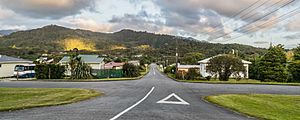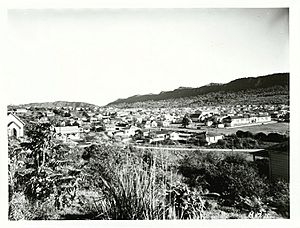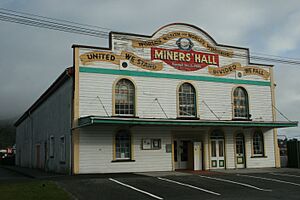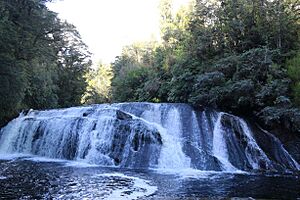Runanga, New Zealand facts for kids
Quick facts for kids
Runanga
|
|
|---|---|

Carroll Street
|
|
| Country | New Zealand |
| Region | West Coast |
| District | Grey District |
| Ward | Northern |
| Electorates |
|
| Area | |
| • Total | 4.51 km2 (1.74 sq mi) |
| Population
(June 2023)
|
|
| • Total | 1,230 |
| • Density | 272.7/km2 (706/sq mi) |
| Local iwi | Ngāi Tahu |
Runanga is a small town on the West Coast of the South Island of New Zealand. It is about eight kilometres northeast of Greymouth, located north of the Grey River. Barrytown is about 21 kilometres further north. State Highway 6 and the Rapahoe Branch railway line pass through the town. Runanga used to be an important railway junction, with another railway line, the Rewanui Branch, splitting off until it closed in 1985.
The town started in the late 1800s when many European settlers arrived to mine coal. The name "Runanga" comes from the Māori word for "meeting place". Even today, coal mining is a main source of jobs in the town.
Contents
History of Runanga
From 1853 to 1876, the area where Runanga now stands was part of the Nelson Province.
Unlike many West Coast towns that grew because of gold mining, Runanga was built to support the local coal mining industry. In 1902, the government decided to open its own coal mines. They declared the entire area north of the Grey River a State Coal Reserve. The Point Elizabeth No. 1 mine began producing coal on March 17, 1904.
In 1903, a sawmill opened in Runanga. This meant that proper timber houses could be built, replacing the tents that many miners lived in. Runanga officially became a borough (a type of town) in 1912. At that time, it covered an area of about 1,210 acres and had a population of around 1,500 people.
People of Runanga
The Runanga area, which includes nearby places like Dunollie and Rapahoe, covers about 4.51 square kilometres. In 2018, Runanga had a population of 1,185 people. This was a small decrease from the 2013 and 2006 census numbers.
In 2018, there were 519 households in Runanga. There were slightly more males than females. The average age was 45.2 years old, which is a bit older than the national average for New Zealand. About 17% of the people were under 15 years old.
Most people in Runanga identify as European/Pākehā (92.9%). About 11.9% identify as Māori. Smaller numbers of people identify as Pasifika, Asian, or other ethnicities. Some people identify with more than one ethnicity.
Most people in Runanga (59.5%) said they had no religion. About 26.3% were Christian. A small number of people followed Māori religious beliefs, Islam, Buddhism, or other religions.
For those aged 15 and older, about 4.6% had a university degree. Many people (34.8%) did not have formal qualifications. The average income in Runanga was $24,400, which was lower than the national average of $31,800. Most adults were employed either full-time or part-time.
Community Life in Runanga
Like many towns, Runanga has had various clubs and groups over the years. One such group was the Runanga Lodge No 74 of the Royal Antediluvian Order of Buffaloes. This lodge started on May 13, 1939. Its first meeting in its own hall was held in April 1943, after previously meeting in rented spaces.
Runanga Miners' Hall
The Runanga Miners' Hall is a very important building. It is listed by Heritage New Zealand as a Category I structure, meaning it has special historical value. The hall is important because of its role in the history of the union movement in New Zealand. It is also one of the few miners' halls still standing. In 2020, a project was announced to strengthen the hall, costing $1.1 million.
Coal Creek Waterfall Walk
You can visit the Coal Creek waterfall by taking the Coal Creek walking track. This track starts in Runanga. It is an easy walk, about 3.6 kilometres long (return trip). The path follows Coal Creek through beautiful beech trees and other native trees. The waterfall is seven metres high and spans the width of the river.
Famous People from Runanga
Many notable people have connections to Runanga:
- Moses Ayrton was a New Zealand politician.
- Paul Caffyn is a well-known sea kayaker.
- George Duggan (1912–2012) was a Marist priest, philosopher, and writer. He was often called Chalky Duggan.
- Dave McKenzie (born 1943 in Dunollie) is a former long-distance runner. He ran for New Zealand in the men's marathon at the 1968 and 1972 Summer Olympics. He also won the Boston Marathon in 1967.
- George Menzies was a famous rugby league player. In 2008, he was named the greatest five-eighth New Zealand had ever produced. He played for Runanga's club.
- James O'Brien was a Labour Member of Parliament for Westland from 1922–25 and 1928–1947. He was also a Minister in the First Labour Government. He lived and worked in Runanga for about ten years starting in 1906.
- Frank O'Flynn, who was the Minister of Defence in the Fourth Labour Government, was born in Runanga in 1918.
- Bob Semple, who was the Minister of Public Works in the First Labour Government, was the President of the Runanga Miner's Union in 1907.
- Paddy Webb, who was the Minister of Mines in the First Labour Government, worked in the Runanga mine around 1906.
Education in Runanga
Runanga School is a school for students in years 1 to 8 (ages 5-13). It is a coeducational school, meaning both boys and girls attend. As of 2024, the school has about 41 students.




